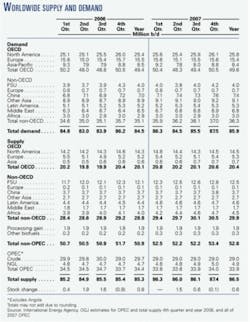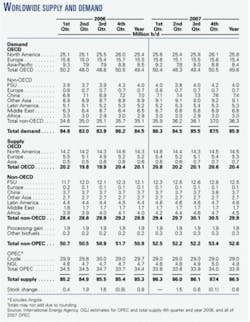Worldwide demand for oil will climb 1.4 million b/d in 2007, following growth of just 900,000 b/d last year.
Production will grow enough this year in countries outside the Organization of Petroleum Exporting Countries to enable OPEC producers to hold exports near 2006 levels.
At its Dec. 14, 2006, meeting in Abuja, Nigeria, OPEC admitted Angola as the 12th member of the organization, effective Jan. 1, 2007. For figures in this article, Angola is considered non-OPEC.
Global oil demand
Demand by member countries of the Organization for Economic Cooperation and Development will post a small increase this year.
OECD demand will average 49.6 million b/d vs. 49.4 million b/d last year, according to the latest figures from the International Energy Agency. All of this growth will be in North America. Demand will contract slightly in the European and Asian countries of the OECD.
Non-OECD countries will account for most of the world’s oil demand growth in 2007, according to IEA. The Paris-based agency forecasts that non-OECD demand will average 36.3 million b/d, up from 35.1 million b/d last year.
Among these countries China will lead demand growth. Oil demand in China this year will be 7.4 million b/d, according to IEA.
Last year China’s oil demand averaged 7 million b/d, compared to 6.6 million b/d a year earlier. In 2004, Chinese demand jumped to 6.4 million b/d from 5.5 million b/d the prior year.
Demand this year in other Asian countries will climb to average 9.1 million b/d from the 2006 average of 8.9 million b/d. And IEA expects oil demand in the Middle East to average 6.8 million b/d this year, up from 6.5 million b/d.
Oil supply
Including Angola, non-OPEC oil supply will climb to 52.6 million b/d this year from 50.9 million b/d.
Supply will grow modestly this year in the OECD, averaging 20.4 million b/d. But non-OECD supply will increase to 29.9 million b/d from 28.8 million b/d last year.
IEA forecasts that oil supplied by the former Soviet Union will get a boost from Russia and Azerbaijan. This will bring average supply from the FSU to 12.5 million b/d, up from 12.1 million b/d last year. IEA warns, though, that the Russian government’s attempts to reinstate control and influence over regional energy assets and infrastructure may impede supply growth.
“Future access to Russian reserves and the legal operating framework remain uncertain. Geopolitical and infrastructure issues, not below-ground risks, may limit the FSU contribution to medium-term non-OPEC growth,” IEA said.
Among the remaining non-OPEC, non-OECD regions, the only supply growth areas are Latin America and Africa. Brazil will drive the increase in Latin America, with nearly 200,000 b/d of incremental crude and ethanol supply this year. The expected average supply boost to 4.5 million b/d from 4 million b/d last year in Africa includes growing output from Angola, where average production is projected to rise to 1.72 million b/d this year from 1.41 million b/d in 2006.
OPEC supply
With the inclusion of Angola into its membership, OPEC will try to hold production in check this year to keep oil prices from falling much below $60/bbl.
The average OPEC basket crude price in 2006 was $61.08/bbl. And the average export price of Saudi Arabian Light crude was $57.22/bbl. A weak US dollar increases OPEC’s incentive to defend crude prices by limiting production.
OGJ forecasts that OPEC crude supply, excluding Angola, will average no more than 29 million b/d this year. This compares to an estimated average of 29.7 million b/d last year, plus NGL supply of 4.7 million b/d. OPEC will supply the market with an average of 4.9 million b/d of NGL this year, according to IEA.
At a December meeting OPEC agreed to reduce the production by 500,000 b/d effective Feb. 1 after announcing a production cut of 1.2 million b/d last October. The effect of the cuts is a new ceiling for members other than Iraq of 25.8 million b/d. Whether Angola will be subject to OPEC’s new output cuts is uncertain.
Saudi Aramco says it is proceeding with plans to increase its production capacity to 12.5 million b/d by 2009 to meet increasing worldwide oil demand. Saudi Arabia’s current production capacity is about 11 million b/d. Last year the kingdom produced on average 9 million b/d of crude.

